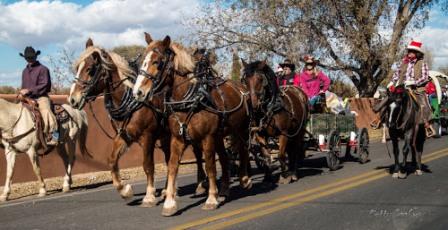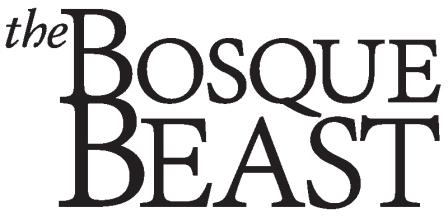
Nutrition, Unwanted horses
among recent concerns
Happy New Year from the Corrales Horse and Mule People! We had a busy schedule of events at the end of 2012, with the annual Corrales Christmas de Caballos Parade on Nov. 18 to benefit the Marine Corps’ Toys for Tots program. The 2.5-mile parade route down Corrales Road started across from the Wagner Corn Maze and ended at the Top Form Arena. This equine-only event draws participants from across the state, and this year from Colorado as well. We counted more than 220 riders and 40 wagons/carts.
Our November meeting featured guest speaker Dr. Matt Paxton of Zia Equine, tal king about equine nutrition. Matt provided an entertainin g and educati onal Q&A session. Some key points:
• Overfeeding is a common problem among horse owners, and leads to founder, laminitis, metabolic syndrome, and many other health issues. To effectively manage nutrition, you need to weigh your feed. Horses’ digestive systems are designed to be fed small amounts frequently. Pasture or frequent feeding are best, otherwise for many owners a slow feeder can be a good alternative.
• Different hays differ greatly in nutritional content, so supplementing with minerals is a good idea.
• Grain, and other carbohydrates that turn to sugar, are not desired in horses any more than in people. Complete feeds that are balanced nutritionally and that include vitamins and minerals can be a good supplement.
• The trend toward rotational worming, or worming when your horse is shod, is considered outdated, especially in our dry climate. The best option is to have a fecal count done to determine if worming is required.
Our January meeting looked at the emotionally charged problem of unwanted horses, with Dr. Dave Fly, New Mexico Livestock Board state veterinarian; Dr. Sonia Swing of the New Mexico Board of Veterinary Medicine; and Rusty Cook, president of the New Mexico Horse Council. Hearing some of the statistics about the problem in New Mexico was staggering.
• New Mexico (including tribal lands) is home to tens of thousands of feral and unwanted horses.
• The state has nine certified horse-rescue operations with a total capacity of 257 head. They are currently holding 266 horses.
• Unwanted horses are routinely turned loose on open space.
• As a border state, New Mexico receives unwanted horses from across the nation.
You can find horse-rescue organizations listed on the New Mexico Livestock Board website. For more insight on the topic, you may want to read the Government Accountability Office (GAO) report “Horse Welfare, Action Needed to Address Unintended Consequences from Cessation of Domestic Slaughter.” The New Mexico Cattle Growers’ Association and New Mexico Farm & Livestock Bureau have also produced the article “Equine Welfare: What IS Humane?”
Our February meeting will be Wednesday the 27th. It will be a potluck dinner to introduce new officers and hear their backgrounds and objectives for the upcoming year. We will discuss topics for future 2013 meetings.
The March meeting will feature a veterinarian on the topic of preparing your horse for spring.
Be sure to include the annual CHAMP Recreation Ride on your calendar, May 4, from the Top Form Arena, beginning at 9 a.m. Other events are listed on the CHAMP website, along with a membership application.

